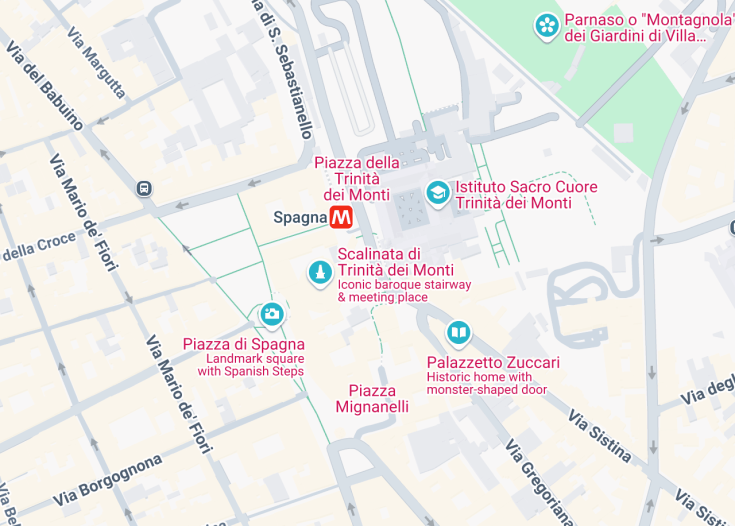The Sallustiano Obelisk, a magnificent ancient monument, stands proudly in front of the church of Santissima Trinità dei Monti in Rome, Italy. Originally erected in the Horti Sallustiani, it showcases the rich history and artistic legacy of Rome, reflecting the city’s enduring grandeur and cultural heritage.
Visitors are encouraged to arrive early in the day to enjoy a tranquil experience. The morning light enhances the beauty of the Sallustiano Obelisk, offering excellent photography opportunities without the crowds that typically accumulate later in the day.
To maximize your experience, consider pairing a visit to the Sallustiano Obelisk with a stroll through the nearby Villa Borghese gardens. This neighboring park provides a serene atmosphere and stunning vistas of Rome, enriching your exploration of the city’s historical treasures.
Sallustiano Obelisk at Trinità dei Monti: A Touch of Ancient Egypt in Rome
The Sallustiano obelisk, prominently located in front of the church of Santissima Trinità dei Monti in Rome, offers visitors a fascinating glimpse into ancient history. Originally erected in the Horti Sallustiani—gardens belonging to the Roman historian Gaius Sallustius Crispus—this impressive structure was brought to Rome in the third century. Its journey through time is intriguing, as it was once broken and abandoned, only to be rediscovered and reinstalled in 1789 under Pope Pius VI’s orders. Standing at 13.91 meters, the obelisk showcases elaborate hieroglyphs that echo the design of the nearby Obelisco Flaminio. The inscriptions on its base mark significant dates in papal history, making this monument a blend of artistic beauty and historical importance. Visitors to this site can enjoy not only the obelisk itself but also the stunning views of the surrounding area, making it a picturesque stop on a Roman adventure. The rich tapestry of history surrounding the Sallustiano obelisk is a must-see for tourists exploring the Eternal City.
Exploring the Attractions Around the Sallustiano Obelisk
When visiting the Sallustiano obelisk at Trinità dei Monti, tourists can indulge in several engaging activities and sights.
Stroll Through the Gardens
One of the highlights is wandering through the adjacent gardens that were once part of the original estate. Here, visitors can experience a blend of history and nature, making it perfect for leisurely walks or picnics.
Photographic Opportunities
The obelisk provides a stunning backdrop for photography. With the iconic church and sweeping views of Rome, capturing the moment here is a must for both casual snapshots and professional photography.
Admiring the Church
Don’t forget to explore the church of Santissima Trinità dei Monti. Its exquisite architectural details and serene atmosphere enhance the experience, creating a deeper connection to Rome’s rich cultural heritage.
Interesting Fact About the Sallustiano Obelisk
An intriguing aspect of the Sallustiano obelisk is its dual inscription, which not only commemorates its installation but also references its history. The longer inscription, carved on the west face, beautifully narrates its journey from being broken and abandoned to becoming a proud symbol of Pope Pius VI’s reign. This historical narrative encapsulates centuries of change and resilience, reflecting how even the simplest stone can carry the weight of time. It stands today not just as a monument but also as a testament to the evolution of Rome and its continuous embrace of the past.
Discover the Majesty of the Sallustiano Obelisk at Trinità dei Monti in Rome, Italy
The Sallustiano Obelisk stands as a magnificent testament to ancient Rome’s historical significance and artistic grandeur. Measuring an impressive 13.91 meters, this obelisk captures the admiration of visitors who traverse the scenic surroundings of the renowned church, Santissima Trinità dei Monti. For history enthusiasts, architecture buffs, and casual tourists alike, this striking monument offers a glimpse into the rich cultural tapestry that defines the eternal city. Visitors will find themselves enchanted by the obelisk’s regal presence, intricately adorned with copies of its ancient hieroglyphs, echoing the glory that once surrounded it in the Horti Sallustiani, the famed gardens of the historian Gaius Sallustius Crispus.
As you approach the obelisk, immerse yourself in the grandeur of the church’s stunning architecture that frames this iconic structure. The Sallustiano Obelisk is not merely a relic; it is a part of the broader narrative of Rome’s artistic evolution through the centuries. Originally erected in the third century, the obelisk boasts an intriguing history, having fallen and been reclaimed multiple times, ultimately being relocated in 1789 by Pope Pius VI. This vividly illustrates Rome’s ongoing commitment to preserving its extraordinary heritage.
Visitors can anticipate splendid views of the surrounding landscapes from this elevated area, making it a perfect spot for photography, meditation, or simply basking in the atmosphere. The inscriptions on the base of the Sallustiano Obelisk further enhance the experience, offering insights into its dedicated past and the reverence that ancient Romans had for such monumental structures.
This majestic monument is ideally situated as a stop on a broader tourist route, nestled amid other significant sights. If you plan your visit strategically, you can seamlessly incorporate this breathtaking monument into a day’s itinerary that may include the panoramic vistas of Villa Borghese or the bustle of Piazza di Spagna. A professional guide might suggest early visits to avoid large crowds, allowing you to connect with the site on a more personal level.
The Best Time to Visit the Sallustiano Obelisk at Trinità dei Monti
To truly appreciate the Sallustiano Obelisk, visiting early in the morning or late in the afternoon is recommended. The soft golden light during these hours enhances the beauty of the obelisk and creates an ethereal atmosphere perfect for photography.
Annual Events to Consider
Every April, the nearby church celebrates its significant anniversary, attracting visitors with various special events. This could be a prime opportunity to partake in the festivities while appreciating the historical obelisk adjacent to the celebrations.
Accessibility and Limitations at the Sallustiano Obelisk at Trinità dei Monti
While the Sallustiano Obelisk is located in a public area, visitors should be aware that certain limitations may affect accessibility. The monument itself is easily accessible; however, the surrounding terrain involves steps and elevated pathways that may pose challenges for those with mobility issues.
Accessibility
Limitations
- Limited seating available in the vicinity for resting.
- Potentially crowded during peak tourist seasons.
- Occasional church events might restrict access to the surrounding areas.
Notes to visitors
- Be mindful of pickpockets in crowded areas.
- Photography is permitted, but avoid using tripods if crowds are large.
- Respect the peaceful atmosphere; consider visiting during quieter hours.
General Information
Details for your visit to Sallustiano Obelisk at Trinità dei Monti
Location
The Sallustiano Obelisk is located in the impressive setting of Trinità dei Monti. When planning your visit, anticipate the beautiful surroundings, including the stunning views available from the adjacent steps and gardens. Key landmarks such as Piazza di Spagna and Villa Medici are nearby, enriching your journey through this historic area.
Address:
Piazza della Trinità dei Monti, 00187 Roma RM, ItalyVisiting Information
The Sallustiano Obelisk is accessible to visitors throughout the day, situated in a public space that encourages exploration and reflection. Morning visits may offer a quieter, more serene experience, while afternoons abound with vibrant energy from incoming tourists.
How to Reach the Sallustiano Obelisk at Trinità dei Monti
Reaching the magnificent Sallustiano Obelisk is straightforward, with various transportation options available from the city’s heart.
Car
Easily accessed by car, there are parking facilities within walking distance from the obelisk, ensuring a convenient visit.
| Route | Distance | Travel time |
|---|---|---|
| From Colosseum | 2 miles (3.2 km) | 10 minutes |
| From Vatican City | 3 miles (4.8 km) | 15 minutes |
| From Termini Station | 1.5 miles (2.4 km) | 7 minutes |
Public Transport
Utilizing public transport is also a great option. The nearest metro station is Spagna (Line A), a short walk from the obelisk.
| Origin | Travel Time |
|---|---|
| From Colosseum Metro Station | 15 minutes |
| From Vatican City Via Bus | 25 minutes |
| From Termini Station Via Metro | 10 minutes |
Nearby Attractions
- Piazza di Spagna – 500 meters (0.3 miles)
- Villa Borghese – 800 meters (0.5 miles)
- Fontana di Trevi – 1 km (0.6 miles)
- Palazzo Barberini – 1.2 km (0.75 miles)
- Via Veneto – 1.3 km (0.8 miles)
- Galleria Borghese – 1.5 km (0.9 miles)
- Trastevere Neighborhood – 2.5 km (1.6 miles)
- Colosseum – 2.6 km (1.6 miles)
- Roman Forum – 2.7 km (1.7 miles)
- Vatican City – 3 km (1.9 miles)
- Castel Sant’Angelo – 3.2 km (2 miles)
- Termini Station – 1.7 km (1.1 miles)
Common Questions
What is the historical significance of the Sallustiano Obelisk in Rome?
The Sallustiano Obelisk, standing at Trinità dei Monti, holds significant historical importance as a symbol of Rome’s ancient past. Originally erected in the Horti Sallustiani, the gardens of the Roman historian Gaius Sallustius Crispus, the obelisk reflects the architectural and cultural grandeur of ancient Rome.
This obelisk was one of many brought to Rome from Egypt by emperors who sought to showcase their power and connection to ancient cultures. It stands as a testament to the Roman practice of erecting colossal monuments that conveyed political messages and religious significance.
In the 18th century, Pope Pius VI relocated and refurbished the obelisk, emphasizing the Catholic Church’s role in Roman heritage and its ongoing spiritual narrative. The inscriptions on its base highlight this transition, showcasing the continuity of Roman history through various regimes.
Thus, the Sallustiano Obelisk not only represents a physical link to ancient Egyptian civilization but also embodies the blend of ancient Roman and Renaissance influences in Rome’s historical landscape.
What architectural style does the Sallustiano Obelisk exemplify?
The Sallustiano Obelisk is a striking example of the Egyptian architectural style in ancient Roman context. Originally crafted in Egypt during the reign of Pharaohs, obelisks like the Sallustiano are characterized by their tall, monolithic structure, featuring a pyramidion on top.
When brought to Rome, these structures were often integrated into the urban landscape, demonstrating the Roman appreciation for Egyptian art and architecture. The Sallustiano Obelisk, decorated with hieroglyphs, exemplifies this merging of cultures. The Roman interpretation involves the erection of the obelisk in a triumphant, elevated position that was often accompanied by monuments celebrating victories and religious significance.
Over time, the obelisk has undergone restoration and has been crowned with symbolic elements, like the Cross, which illustrates the evolution of its meaning from a pagan symbol of sun worship to a Christian emblem.
Consequently, the architectural style of the Sallustiano Obelisk stands as a testament to the adaptability and transformation of cultural symbols throughout history, reflecting the layered narratives of both ancient Egypt and medieval Rome.
Are there any notable features or inscriptions on the Sallustiano Obelisk?
Yes, the Sallustiano Obelisk is adorned with several notable features and inscriptions that shed light on its history and significance. One of its most striking characteristics is the presence of hieroglyphs covering its surface, which were originally inscribed in Egypt and represent the obelisk’s dedication to a pharaoh.
On the base of the obelisk, you will find three inscriptions. The first two shorter inscriptions provide the dates associated with its relocation in 1789 under Pope Pius VI. Specifically, they read:
- III EIDVS / APRIL / ANNO M DCC / LXXXVIIII (The third day before the Ides of April in the year 1789)
- SACRI / PRINCIPATVS / EIVS / ANNO XV (The fifteenth year of his pontificate)
The longer inscription, located on the west face, conveys a memorial message from Pope Pius VI, affirming the obelisk’s historical journey and its new dedication to the Holy Trinity. It summarizes the obelisk’s past, mentioning its broken condition before it was renewed and placed atop a hill, crowned with a cross.
Overall, the inscriptions and features not only allow visitors to appreciate the obelisk’s artistic craftsmanship but also connect them to the historical narrative shaped by various eras in Rome.
What stories or legends are associated with the Sallustiano Obelisk?
The Sallustiano Obelisk holds various stories and legends that have developed since it was erected in Rome. One of the more intriguing tales relates to its alleged magical properties, which were believed to be inherent in ancient Egyptian artifacts. These legends often revolved around themes of power, protection, and spiritual significance.
Local folklore suggested that the obelisk possessed the power to ward off evil spirits, and many Romans believed that its presence contributed to the harmony of the surrounding area. As such, it became common for locals to gather near the obelisk to partake in festivities and pay homage to its stature.
Additionally, some stories link the obelisk to historical events or figures in Rome, especially during the Renaissance when it was re-dedicated by Pius VI. Many visitors believed that its alignment with the Church created a sacred aura, perhaps merging ancient pagan beliefs with Christian ideologies.
While these legends may not be historically substantiated, they indicate the obelisk’s role in the cultural imagination of Rome, illustrating how ancient monuments continue to inspire awe and reverence among both locals and tourists alike.
How does the Sallustiano Obelisk fit into Rome's larger collection of obelisks?
The Sallustiano Obelisk is one among the numerous obelisks that embellish the city of Rome, contributing to its rich tapestry of historical and architectural landmarks. Rome is home to a total of 13 ancient obelisks, many of which were imported from Egypt during the reign of the Roman Empire and serve as markers of the city’s imperial might.
Each of these monumental structures showcases the Romans’ fascination with Egyptian culture, representing not only the triumph of the Roman conquest but also the integration of diverse elements into their existing frameworks. The Sallustiano Obelisk, specifically, is significant due to its original placement in the gardens of a prominent Roman figure and its subsequent journey through various locations in the city.
In terms of style and design, the Sallustiano is consistent with other obelisks, featuring a pyramidion at the top and hieroglyphics etched along its sides. However, its relocation to the Trinità dei Monti area adds a unique context, combining the sacredness of the Church with the grandeur of ancient architecture.
Visitors to Rome will find that each obelisk they encounter tells a unique story, and the Sallustiano Obelisk is no exception—serving as a vital link in connecting the ancient past with the modern-day appreciation of Rome’s historical significance.

Is the Sallustiano Obelisk at Trinità dei Monti in Rome worth visiting?
The Sallustiano Obelisk, located in front of the beautiful church of Santissima Trinità dei Monti, is a fascinating historical monument. It provides tourists with a glimpse into ancient Rome’s grand heritage. Standing 13.91 meters tall, it originally hailed from the Horti Sallustiani, the gardens of the historian Sallust, and was moved to its current location in 1789.
Visitors can appreciate its remarkable inscriptions and learn about its history, including the tales of its decline and restoration under Pope Pius VI. Additionally, the area around the obelisk offers stunning views of the city, enhancing the overall experience. For those intrigued by archaeology and historical architecture, this site is certainly worth the visit.









